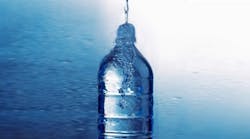Still, today's attitude is, "Out of the tap? Eww!" But put it in a package that's not sustainable no matter how thin its walls and how tiny its cap, and most of us will plunk down cash for it. Just plain crazy, especially when most municipal drinking water is just as good as bottled. In fact, lots of bottled water is just tap water.
So what are we buying? Wasteful plastic, a little portability and a crumb of prestige. "I've got bottled water from Fiji, while you peasants have to drink from a water fountain." However, beyond simple one-upmanship, why do we do something so obviously counterproductive? I think it may just be perceived value caused by illusory scarcity.
Even in print and online publishing, content that people have to pay for is more highly valued than what's free—no matter the usefulness of the information. On the reporting side, I must confess I've sometimes considered a moratorium on water and wastewater stories because I've written so many of them, and they seem, well, pretty bland. They're just not as cool as oil rigs, biochemical reactors and microbreweries. But why isn't water treatment cool? Again, its stories are more available, and so I've taken them for granted, too. I'm sorry.
To cure my prejudice and right this wrong, I'm writing up two case studies on water collection and treatment applications. The first is about the Water Production Dept. in Enid, Ok., which is building a new plant, planning a reservoir and adding a variety of efficient process controls to manage its expanding production and treatment facilities, including the implementation of Iconics' Genesis64 HMI/SCADA software.
[pullquote]The second is about the Ontario-based Windsor Utilities Commission (WUC), which was also long overdue for some new controls to maintain the reliability of its water production system. It's using Rockwell Automation's ControlLogix PACs and FactoryTalk VantagePoint software for its upgrade. Both of these stories are available online at www.controlglobal.com/watertreatment.
Still, beyond covering and paying attention to useful water treatment applications, what else can be done? Well, how about learning what life is like in places where water really is scarce or threatened? To communities, families and mostly girls and women in East Africa, available water means freedom from having to waste hours each day fetching it—hours that can be spent at school. To learn more, read "The Burden of Thirst" in National Geographic at http://ngm.nationalgeographic.com/2010/04/water-slaves/rosenberg-text.
Personally, I've seen ostentatious displays and overuse of water in Las Vegas and Palm Desert, Calif. I thought then that it was almost like a psychological denial of the severe desert environment just beyond the unnaturally green golf course. Anthropologists have long theorized on why the Anasazi left these regions long ago. Well, they likely went to the same place many folks now living in those deserts are going to go when the groundwater runs out, and the salt rises high enough in the soil to make it unusable. To learn more, read Cadillac Desert by Marc Reisner, or view the video about the book at www.youtube.com/watch?v=hkbebOhnCjA&feature=player_embedded
Or maybe, the next time you're thirsty, just pay attention to it for few minutes. Get a feeling for what being parched is really like. Being hungry is uncomfortable, but true thirst is painful. Just thinking about being thirsty makes me thirsty, so I know it can quickly remind me not to take water for granted. How about you?






